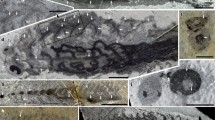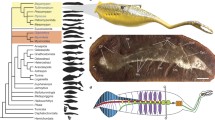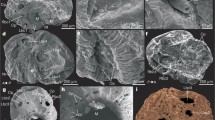Abstract
The Early CambrianHaikouichthys and Haikouella have been claimed to be related to contribute in an important way to our understanding of vertebrate origin, but there have been heated debates about how exactly they are to be interpreted. New discoveries of numerous specimens ofHaikouichthys not only confirm the identity of previously described structures such as the dorsal and the ventral fins, and chevron-shaped myomeres, but also reveal many new important characteristics, including sensory organs of the head (e.g. large eyes), and a prominent notochord with differentiated vertebral elements. This “first fish” appears, however, to retain primitive reproductive features of acraniates, suggesting that it is a stem-group craniates. A. new order (Myllokunmingiida) and a new family (Myllokunmingiidae) are erected, and a new species,Zhongjianichthys rostratus (gen. et sp. nov.), is described herein. Over 1400 newlydiscovered specimens ofHaikouella provide a wealth of anatomical information on this organism. It differs from chordates in many organs and organ systems, including the skin, muscles, respiratory, circulatory and nervous systems. In contrast, its body-design resembles that of vetulicolians, and the presence of a “transitional” nervous system with both dorsal and ventral nerve cords suggests an affinity with living hemichordates. On the basis of these and other recent findings of fossil deuterostomes, a five-step hypothesis for vertebrate origin is proposed, intended to bridge the longstanding gap between protostomes and vertebrates. Four of the five steps accord with established ideas current in modern evolutionary zoology. Evidence for the first step is obtainable only from fossils, and specifically from fossils found from South China, hence the crucial importance of S. China sites for our understanding of early vertebrate origins and evolution. Accordingly, South China is suggested as the oldest-known birthplace of the whole vertebrates.
Similar content being viewed by others
References
Garstang, W., The morphology of the Tunicata and its bearing on the phylogeny of the Chordata, J. of the Microscopical Society, 1928, 72: 51–87.
Berrill, N. J., The Origin of Vertebrates, Oxford Oxford University Press, 1955.
Romer, A. S., The Vertebrate Story, Chicago: University of Chicago Press, 1971.
Schaeffer, B., Deuterostome monophyly and phylogeny, Evoln. Biol., 1987, 21: 179–235.
Gee, H., Deuterostome phylogeny: The context for the origin and evolution of the vertebrates, in Major Events in Early Vertebrate Evolution: Palaeontology, Phylogeny, Genetics and Development (ed Ahlberg, P. E.), London and New York: Taylor and Francis Inc., 2001.
Bromham, L. D., Degnan, B. M., Hemichordate and deuterostome evolution: robust molecular phylogenetic support for a hemichordate + echmoderm c Cameron, C. B., Garey, J. R, Swalla, B. X, Evolution of the chordate body plan: new insights from phylogenetic analyses of deuterostome phyla, Proc. Natl. Acad. Sci. USA, 2000, 97: 4469–4474.
Lacalli, T. C., Holland, N. D., West, J. E., ‘Landmarks m the anterior central nervous system of amphioxus larvae’, Phil. Trans. Royal Soc. Lond. B, 1994, 344: 165–485.
Jefferies, R. P. S., The ancestry of the vertebrates. London, British Museum (Natural History), Cambridge: Cambridge University Press, 1986.
Jefferies, R. P. S., The origin and early fossil history of the chordate acustio-lateralis system, with remarks on the reality of the echinoderm-hemichordate clade, in Major Events in Early Vertebrate Evolution: Palaeontology, Phylogeny, Genetics and Development (ed Ahlberg, P. E.), London and New York: Taylor and Francis Inc., 2001.
Shu, D. G., Geyer, G., Chen, L. et al., Redlichiacean trilobites with preserved soft-parts from the Lower Cambrian Chengjiang fauna, Beringaria, Special Issue, 1995, 2: 203–241.
Shu, D. G., Zhang, X. L., Geyer, G., Anatomy and systematic affinities of Lower Cambrian bivalved arthropodIsoxys auritus, Alcheringa, 1995, 19: 333–342.
Chen, J. Y., Zhou, G. Q., Biology of Chengjiang biota, Bull, Natl. Mus. Nat. Sci. Taiwan, 1997, 10: 11–405.
Hou, X. G., Bergstrom, I., Arthropods from the Lower Cambrian Changjiang Fauna, Sonthwest China, Fossils and Strata, 1997, 45: 1–115.
Shu, D., Vannier, J., Luo, H. et al. Anatomy and lifestyle of Kunmingella (Arthropoda, Bradoriida) from the Chengjiang fossil Lagerstatte (lower Cambrian; Southwest China), Lethaia, 1999, 32: 279–298.
Zhang, X. L., Shu, D., Li, Y. et al., New sites of Chengjiang fossils: crucial windows on the Cambrian explosion, J. Geol. Society, Lond, 2001, 158: 211–218.
Kardong, K., Vertebrates: Comparative Anatomy, Function, Evolution McGraw-Hill, Boston, 1997.
Shu, D., Zhang, X. L., Chen, L., Reinterpretation of Yunnanozoon as the earliest known hemichordate, Nature, 1996, 380: 428–430.
Shu, D., Conway, M., S., Zhang, X. L., A. Pikaia-like chordate from the Lower Cambrian of China, Nature, 1996, 384: 157–458.
Shu, D., Chen, L., Han, J. et al., The early Cambrian tunicate from South China, Nature, 2001, 411: 472–473.
Shu, D., Chen, L., Han, J. et al., Chengjiang Lagerstatte and earliest-known chordates, Zoological Science, 2001, 18: 447–448.
Chen, J. Y., Dzik, J., Edgecombe, G. D. et al., A. possible early Cambrian chordate, Nature, 1995, 377: 720–722.
Chen, J., Huang, D. Y., Li, C. W., An Early Cambrian craniatelike chordate, Nature, 1999, 402: 518–521.
Shu, D., Conway, M. S., Han, J. et al., Primitive deuterostomes from the Chengjiang Lagerstatte (Lower Cambrian, China), Nature, 2001, 414: 419–424.
Shu, D., Conway, M. S., Zhang, X. et al, A. pipiscid-like fossil from the Lower Cambrian of South China, Nature, 1999, 400: 746–749.
Shu, D., Luo, H., Conway, M. S. et al. Early Cambrian vertebrates from South China, Nature, 1999, 402: 42–46.
Shu, D. G., Chen, L., Mosaic evolution of the earliest-known vertebrates, Geosciences (in Chinese with English abstract), 2000, 14: 315–322.
Shu, D. G., Conway, M. S., Han, X. et al. Head and Backbone of the Cambrian vertebrateHaikouichthys, Nature, 2003, 421: 526–529.
Mueller, W. A., Developmental Biology, Beijing and Spring-Verlag Berlin Heidelberg, China Higher Education Press, 1998.
Janvier, P., Catching the first fish, Nature, 1999, 402: 21–22.
Holland, H. D., Chen, J. Y., Origin and early evolution of the vertebrates: new insights from advances in molecular biology, anatomy, and palaeontology, BioEssays 2001, 23: 142–151.
Jarvik, E., Basic Structure and Evolutionof Vertebrates, 2 vol. New York and London: Academic Press, 1980.
Cohn, M. J., Lamprey Hox genes and the origin of jaws, Nature, 2002, 416: 386–387.
Bardack, D., Zangerl, R., Lamprey in the fossil record, The Biobgy of Lampreys (eds. Hardisty, M. W., Potter, I. C.), London: Academic Press, 1971, 1: 67–84.
Bardack, D., Richardson, E. S., New agnathous fishes from the Pennnsylvanian of Illinois, Fieldiana: Geology 1977, 33: 489–510.
Janvier, P., Early Vertebrates, Oxford Clarendon Press, 1996.
Dzik, J., Yunnanozoon and ancestry of chordates, Acta Palaeont, Polonica, 1995, 40: 341–360.
Hou, X. G., Ramskoeld, L., Bergstroem, J., Composition and preservation of the Chengjiang fauna—a Lower Cambrian softbodied biota, Zool, Scripta, 1991, 20: 395–411.
Shu, D. G., Conway, M. S., Zhang, Z. F. et al, A. New Species of Yunnanozoans with Implications for Deuterostome Evolution, Science, 2003, 299: 1380–1384.
Lacalli, T. C., Vetulicolians—are they deuterostomes? chordates? BioEssays, 2002, 24: 208–211.
Gee, H., On thevetulicohans, Nature, 2001, 414: 407–409.
Conway, M. S., The Crucible of Creation: The Burgess Shale and the Rise of Animals, Cambridge: Cambridge Univ. Press, 1998.
Bergestroem, J., Origin of high-rank groups of organisms, Paleontological Reserch, 1997, 1: 1–14.
Briggs, D. E. G., Kear, A. J., Decay of the lancelet Branchiostoma lanceolatum (Cephalochordata): implication for the interpretation of soft-tissue preservation in conodonts and other primitive chordates, Lethaia, 1994, 26: 275–287.
Smith, M. P., Sansom, I. J., Cochrane, D., The Cambrian origin of vertebrates, in Major Events in Early Vertebrate Evolution: Palaeontology, Phylogeny, Genetics and Development (ed Ahlberg, P. E.), London and New York: Taylor and Francis Inc., 2001.
Harvey, Pough F., Heiser, J. B., McFarland, W. N., Vertebrate Life (Third edition), New York: MacMillan Pulbishing Company, 1989.
Luo, H. L., Hu, S. X., Chen, L. Z., New Early Cambrian chordates from Haikou, Kunming, Acta Geologica Sinica, 2001, 75: 345–348.
Gee, H., Before the Backbone: Views on the Origins of the Vertebrates. London, Chapman & Hall, 1996.
Nielsen, C., Animal Evolution: interrelationships of living phyla (2nd ed.), Oxford Oxford University Press, 2001.
Wada, H., Satoh, N., Details of the evolutionary history from invertebrates to vertebrates, as deduced from the sequences of 18S rDNA, Proc. Natl. Acad. Sci. USA, 1994, 91: 1801–4804.
Paul, C. R. C., Evolution of primitive echinoderms, in Patterns of Evolution (ed Hallam, A.), Amsterdam: Eiservier Scientific Publ. Comp., 1977.
Luo, H. L., Hu, S. X., Chen, L. Z., Early Cambrian Chengjiang Fauna in Kunming Region (in Chinese with English summery), Kunming: Science and Technology Press of Yunnan Province, 1999.
Domingues, P., Jacobson, A. G., Jefferries, R. Paired gill slits in a fossil with a calcite skeleton, Nature, 2002, 417: 841–844.
onway, M. S., Why molecular biology needs palaeontology, Development, 1994(Supp.): 1–13.
Ayala, F. J., Rzhetsky, A., Origin of metazoan phyla, Molecular clocks confirm palaeontological estimates, Proc. Natl. Acad. Sci., USA, 1998, 95: 606–611.
Author information
Authors and Affiliations
Corresponding author
About this article
Cite this article
Shu, D. A paleontological perspective of vertebrate origin. Chin.Sci.Bull. 48, 725–735 (2003). https://doi.org/10.1007/BF03187041
Received:
Issue Date:
DOI: https://doi.org/10.1007/BF03187041




